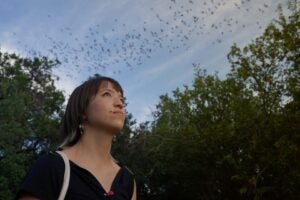AUSTIN, Texas — What better way to learn more about the instruction of classics than to sit at the foot of a scholar renowned for his teaching and research on Greek and Roman classic civilizations. That’s just what 15 teachers from small colleges around the country did this summer at The University of Texas at Austin – they became immersed in the Karl Galinsky method.”He’s our Socrates,” said Kristina Board of Galinsky. “He teaches by asking questions.”
Board, an instructor at Cossatot Technical College in Arkansas, was participating in a National Endowment for the Humanities summer institute held at UT. She and other educators spent seven weeks on campus under the tutelage of Galinsky who holds the Floyd A. Cailloux Centennial Professorship in classics. They attended seminars, delivered reports and were able to pursue individual research and study projects at the University’s library facilities. Competition for the summer NEH grants is stiff and Galinsky’s seminar was one of only 13 held this year. Other subjects were taught at Harvard University, Johns Hopkins University and Columbia University, among others. The project was started by NEH in the early 1970s to provide academics who teach in non-Ph.D. granting humanities departments an opportunity to enrich their knowledge and conduct research at a university with excellent library and computer facilities.
The college teachers had 24-hour access to the Classics Library in Waggener Hall, in addition to regular hours at the Perry-Castaneda Library, the fifth-largest academic library in North America. The Classics Library, which contains 25,000 volumes of major texts and commentaries, is a fully funded branch library – professionally staffed and operated. Computer facilities also were available to the participants.
“These are instructors from smaller institutions who typically have huge teaching loads — four or five courses a semester — and who don’t have very good research facilities,” said Galinsky. “They know these seminars can be tremendously useful and, thus, come really motivated.” Galinsky, who was chairman of the UT Austin Department of Classics for several years, is the author of several books about the classics, most recently Augustan Culture: An Interpretive Introduction published by Princeton University Press in 1996. He has taught two other NEH summer seminars for college teachers.
“These seminars are a bank of knowledge, and I am thrilled to be benefiting from it,” said James Lockett, professor of history at Stillman College in Tuscaloosa, Ala. “It is an opportunity to sharpen and expand our knowledge and discover new teaching tools to integrate into our classrooms.”Another teacher said he appreciated the opportunity to meet other scholars in the humanities from around the country. “We’re all at various stages in our academic careers, and it’s nice to see what others are thinking and working on,” said Ronald Harris, an assistant professor of English at Southeastern Louisiana University.
“Roman Culture in the Age of Augustus” was the title of Galinsky’s summer seminar this year. “The Augustan Age (31 B.C. to A.D. 14) was one of the most seminal and creative periods of western civilization,” said Galinsky. “It witnessed the establishment of order after a century of turmoil — marking the transition from Republic to Empire — and it was a high point of literary and artistic creativity.”
The seminar included teachers from the field of literary classics, as well as other disciplines such as history, political science, art history, English, religion and the Romance languages and literatures. During the seven weeks, seminar participants discussed morals and values of the period, Augustan poetry, Augustan art and architecture and religion. “We wanted to look at the whole cultural experience of the time – not just history or classics,” said Galinsky.
The teachers also had a chance to present some of their own research to the class. Sherill Spaar of East Central University in Oklahoma, for example, talked to her colleagues on the subject of natural order and “space” in classical antiquity. She related this topic to the architectural structures in Austin– the UT tower being the “sacred center,” which epitomizes the collective raison d’etre of the city, connected to the State Capitol by axis. Most Greek and Roman town planning and sense of distinctive culture, she said, stemmed from the regard of the sacred center.
Another instructor talked about the freedom of speech in the Age of Augustus, and another delivered a talk on “The Legacy Bequeathed to Us by the Romans.”



